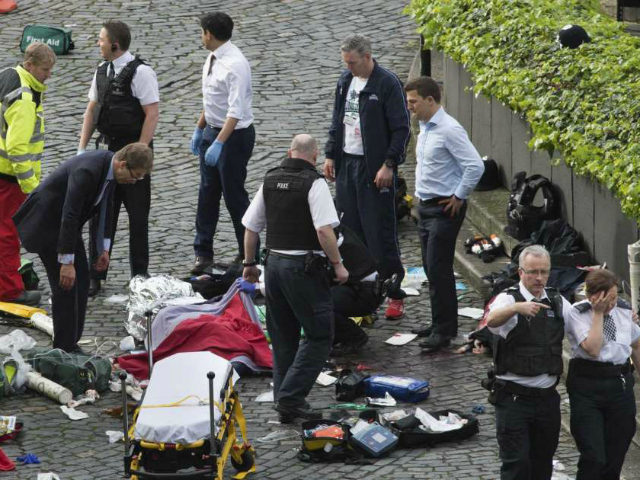SiriusXM host Raheem Kassam welcomed former Department of Homeland Security official Philip Haney, author of See Something, Say Nothing: A Homeland Security Officer Exposes the Government’s Submission to Jihad, back to Breitbart News Daily on Thursday morning. Naturally, the terrorist attack in London was the primary topic of conversation.
Haney recalled appearing with Kassam on Wednesday’s edition of Sean Hannity’s show, where they discussed the difference between “indicators that might help you get focused on the circumstances of an attack like yesterday” and “proven derogatory information.”
“You can develop indicators in a situation like yesterday without necessarily determining whether they’re really proven derogatory or not,” he said. He cited the terrorist attacks in San Bernardino, Fort Hood, and Chattanooga as cases where “there were indicators that were seen by different law enforcement, particularly FBI, which is domestic law enforcement, and then my own former agency, Customs and Border Protection, which was our primary job; Department of Homeland Security was created to help protect our country from terrorism.”
“The way we constructed cases, which is commonly known as ‘connecting the dots,’ was to put pieces of information into the system until a point came when you could paint a picture, either of an individual or of an organization because there was a relationship between an individual who does an attack or may do an attack and an affiliated network of either other individuals or organizations,” he elaborated.
Haney noted that the London attacker was evidently known to law enforcement. “I also just read that they’ve also arrested eight other people, which is perfect proof of my operating premise that these individuals virtually are never alone,” he added.
“This notion that we have of individuals that are suddenly radicalized, just kind of out of the clear blue, is really not a correct premise because as we’re now discovering with the individual from the attack yesterday that there are other people involved in some way or another. It always amazes me how they’re able to find this out after an attack, but it doesn’t seem like they’re able to manage it quite as effectively before an attack occurs,” he said.
Haney thought this was a consequence of the limited “arena that law enforcement is allowed to operate in and how they’re able to respond to indicators that they might find,” not a shortage of resources.
“It’s been the prevailing notion that law enforcement tends to be limited in their ability to respond to the evidence that they see lately,” he noted unhappily.
“We’ve been seeing these kind of vehicle attacks all the way back to Beirut, with the Marine barracks twenty, thirty years ago,” Haney pointed out. “As soon as I began to see the details of the story come out in the media, the picture came clear in my mind that this is very similar to the kind of attacks we’ve seen in Nice and/or Beirut, as I mentioned, and in Germany’s Christmas market.”
“That’s another arena of indicators when you’re evaluating a terrorist attack. If you’re a law enforcement officer, that’s your first and primary job, to try to put the picture together as quickly as you can, for one major reason: you don’t know at the time of attack if that’s the only person involved. You do your best to put the picture together as clearly and as quickly as possible as an indicator of a possible course of action, a response to the terrorist attack,” he advised.
“As an outside observer, I took the evidence that was being provided by the media – in particular, the Guardian – and evaluated the pictures that they had shown of the MPs, the medical people, working on the individual that had been shot. Just from that picture, I was able to make some determinations, kind of focus down on the type of person that he probably was. With my background, I knew immediately that it was likely he was affiliated with other individuals, either directly and/or indirectly,” he explained.
“It looked to me like he was going to crash through the gate if at all possible, and the smaller wall stopped him from going through,” Haney assessed.
“You put the picture together, and then you respond in a law enforcement manner from there. That’s how I saw it as I evaluated it yesterday as the story was unfolding,” he said.
Haney speculated that law enforcement withheld the identity of the attacker for as long as possible to “keep the individuals that they’re tracking” from escaping the dragnet. He thought it was reasonable for British counter-terrorist units to “give themselves as much of a tactical advantage as they possibly can maintain, for as long as they can maintain it.”
“Likely, people will go underground because that’s what always happens. Remember the attacks in Brussels? There were individuals that were involved in the attack that were basically hiding in plain sight, right in communities. It took months, if not longer, to find some of them,” he recalled.
“The other indicator, by the way, is what happened in the U.K. with the individuals arrested on the street or detained on the street, for asking other people in a protest questions about Islam. They intervened and took him off the street. That’s kind of a variation on the ‘see something, say something’ theme, that if you do see something and say something, oftentimes you end up getting in trouble for bringing it up,” Haney said.
Breitbart News Daily airs on SiriusXM Patriot 125 weekdays from 6:00 a.m. to 9:00 a.m. Eastern.
LISTEN:

COMMENTS
Please let us know if you're having issues with commenting.